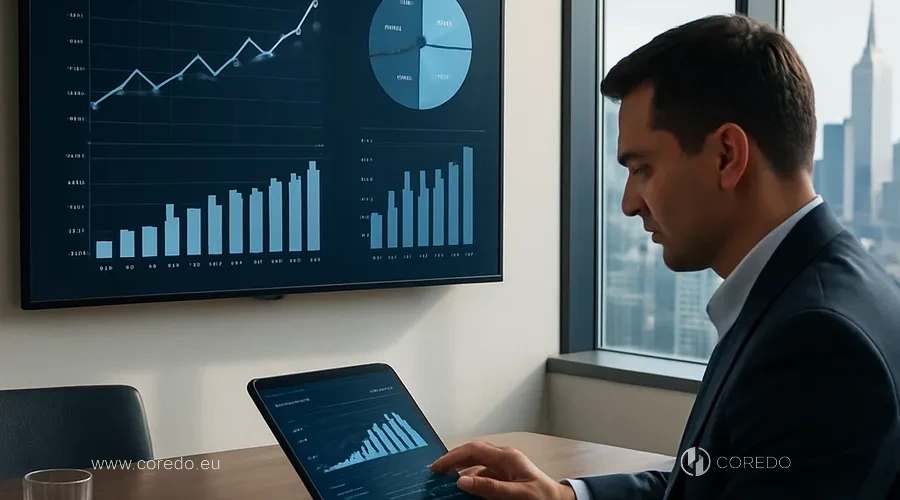In 2024 more than 30% of new private equity funds in Europe and Asia are launched on a rolling model, and the volume of capital raised through a subscription investment model has doubled over the past three years, data from PitchBook show. Why are rolling funds becoming the key tool for strategic growth and portfolio diversification right now? How can you ensure investment flexibility and transparency for LPs/GPs without losing control over risks and meeting AML/Compliance requirements? And most importantly: what practical steps will allow entrepreneurs and CFOs to implement rolling funds into their investment strategy as effectively as possible?
The COREDO team faces these questions daily while supporting international projects to launch and manage rolling funds in the EU, Asia and the Middle East. In this article I will examine in detail how the rolling fund structure in private equity works, how rolling funds fundamentally differ from traditional funds, which legal and compliance nuances need to be considered, and which solutions have proven effective in practice. If you are looking not just for an overview but for a practical guide and strategic ideas to scale your business through alternative investments, I recommend reading to the end.
Rolling funds: what they are and how they work?

Rolling funds are an innovative format of private equity and venture funds built on a subscription investment model and a series of funds (fund series), where capital is raised not all at once but regularly through periodic capital calls. This investment structure allows the GP (general partner) to dynamically grow assets under management, while LPs (limited partners) can flexibly enter and exit the fund according to their own strategic goals.
Unlike classic funds with a fixed term and size, rolling funds use continuous capital collection through subscriptions: LPs can join each new fund series, which ensures a steady inflow of investors and dynamic allocation of capital. In practice, the COREDO team has implemented projects where rolling funds were launched both in the form of Delaware LPs and in European and Asian jurisdictions, taking into account local requirements for governance structure, public investor solicitation, and administration automation.
- Subscription model of funds: LPs subscribe to participate in subsequent series, which lowers the entry barrier and allows flexible management of minimum and maximum contributions.
- Fund series: each series is a separate investment pool with its own reporting, which facilitates monitoring of the investment portfolio and the exit strategy.
- Periodic capital calls: the GP initiates fundraising within each series, ensuring liquidity management and adaptation to market conditions.
- Public investor solicitation: modern platforms (for example, AngelList rolling funds) allow automation of Due Diligence, KYC/AML and administrative fees, providing transparency for LPs/GPs.
Thus, rolling funds form a new paradigm of interaction between the investor and the manager; let us consider how they differ from classic venture and private equity funds.
Differences between rolling funds, venture and private equity funds
When comparing rolling funds and traditional closed-end funds, it is worth highlighting several fundamental differences that determine their attractiveness for international investors and managers:
- Investment flexibility: rolling funds offer LPs the ability to enter and exit at each stage, not only at the beginning of the fund’s lifecycle. This is especially important for institutional and individual investors focused on risk diversification and adapting to changing market conditions.
- Continuous capital raising: unlike one-time fundraising, rolling funds provide a continuous flow of investments and the ability to quickly respond to new market opportunities.
- Fund structure with series: each series is an independent investment pool, which simplifies public disclosure, reporting and the exit strategy for LPs.
- Transparency and reporting: rolling funds are forced to implement more advanced monitoring and disclosure systems, which increases trust from investors and regulators.
- Public investor solicitation: modern rolling funds actively use marketing strategies to expand the LP base, which accelerates fund scaling.
Implementing projects to launch rolling funds for COREDO clients in the EU and Asia, I note: rolling funds are especially effective for startups and fast-growing companies that need quick access to capital and a flexible investor attraction strategy.
| Criterion | Rolling Funds | Traditional funds |
|---|---|---|
| Investment flexibility | High (subscription model, series) | Low (fixed term) |
| Liquidity | Higher (periodic capital calls) | Lower (locked capital) |
| Transparency | Increased (reporting by series) | Standard |
| AML/Compliance | Requires automation and monitoring | Requires comprehensive control |
| Scalability | Easy (platforms, public solicitation) | Difficult (long cycle) |
Benefits of rolling funds for investors

The benefits of rolling funds for investors lie in a unique combination of accessibility and flexibility that traditional venture capital does not offer. Rolling funds allow regular investments in small amounts and quick strategic maneuvering, which makes this mechanism especially attractive for those who value flexibility and liquidity.
Rolling funds: flexibility and liquidity
One of the main advantages of rolling funds is flexibilityinvesting and higher liquidity compared to traditional funds. LPs gain the opportunity to diversify their portfolio by participating in different series, and GPs: effectively manage the risks of rolling funds by using dynamic capital allocation and regular monitoring of the investment portfolio.
- Risk diversification: participating in multiple series of a rolling fund reduces capital concentration and increases portfolio resilience.
- Investment liquidity: LPs can increase or decrease their participation in the fund at each stage, which is especially important for corporate and institutional investors.
- Investment portfolio monitoring: modern rolling funds implement systems for automatic monitoring and performance analysis of each series.
Interaction between LPs and GPs: transparency and reporting
In current conditions, transparency and reporting of rolling funds have become key requirements for both investors and regulators. The solution developed by COREDO for a European fund included the implementation of a platform to automate due diligence, KYC/AML and administrative fees, which enabled rolling fund GPs to provide transparency for LPs and improve interaction efficiency.
- Transparency for LPs/GPs: regular reporting for each series, public disclosure of information about the fund structure and investment strategies.
- Performance fee and management fee: rolling funds often use flexible remuneration models where the performance fee and the manager’s fee (management fee) are calculated per series, which increases GP motivation and transparency for LPs.
- Due diligence and administrative fees: process automation reduces costs and accelerates investment decision-making.
Performance metrics of rolling funds
Evaluating the performance of rolling funds requires the implementation of specific KPIs and metrics that reflect subscription dynamics, returns by series, and the level of portfolio diversification. COREDO projects use the following tools:
- Hurdle rate (minimum return threshold): the minimum level of return, above which the GP receives a performance fee.
- IRR (Internal Rate of Return) by series: analyzed separately for each series, allowing LPs to make informed decisions about further participation.
- Dynamics of LP attraction: subscription rates and investor retention rate, key indicators of rolling fund sustainability.
- Investment portfolio monitoring: automated reports on asset structure, risks and exit strategy.
Legal support for rolling funds in the EU, Asia, Africa

Legal support for rolling funds in the EU, Asia, Africa requires a deep understanding of the unique regulatory features of each jurisdiction, since the structure of such funds is based on continuous capital raising through quarterly subscriptions and differs from classic investment schemes. Each region has its own registration requirements, transparency and reporting requirements for rolling funds, which directly affect the choice of structure and subsequent legal procedures.
Taking these regional differences into account, we will now consider the specifics of the structure and regulatory requirements for rolling funds in individual countries.
Structure and requirements for rolling funds by country
Launching rolling funds requires a deep understanding of the legal nuances of setting up a fund in the chosen jurisdiction. In the EU and Asia, regulation of private investment funds differs in requirements for structure, minimum LP contributions and public fundraising procedures.
- Delaware LP: the most popular legal structure for rolling funds, used for international investors and public capital raising.
- Legal advice on fund structures: analysis of requirements for minimum and maximum LP contributions, features of a fund structure with series and exit procedures (exit strategy).
- Fund administration automation: modern rolling funds use SaaS platforms to manage subscriptions, reporting and compliance.
AML, KYC and compliance for rolling funds
Compliance with AML/KYC and compliance standards is a mandatory condition for scaling rolling funds in Europe and Asia. COREDO’s practice shows that automating due diligence and implementing digital platforms allows not only faster LP onboarding, but also reduces compliance risks when scaling the fund.
- KYC/AML in private equity: integration with international databases, automation of beneficiary and source-of-funds checks.
- Due diligence for rolling funds: regular audit of the fund structure, investment strategies and capital management processes.
- Transparency for LPs/GPs: implementation of dashboards for online monitoring of compliance status and reporting.
Taxes and investments through rolling funds
Tax optimization of investments: one of the key factors when choosing a jurisdiction and structure for a rolling fund. In the EU and Asia, the tax consequences of investing through rolling funds depend on the fund’s structure (Delaware LP, SLP, offshore entities), the status of the LP and the specifics of profit distribution.
- Tax aspects of rolling funds: the possibility of using parallel funds and offshore structures to minimize tax burden is analyzed.
- TaxTax optimization of investments: application of double taxation avoidance agreements, structuring management fee and performance fee to reduce tax costs.
- Monitoring changes in legislation: the COREDO team regularly updates procedures in line with new EU and Asian requirements.
How to launch a rolling fund for an international company

Rolling fund is a modern model of venture investing, where funds are raised from investors through regular subscriptions rather than a single large round. This approach is especially relevant for international companies: it simplifies capital raising, provides flexibility for investors and allows rapid market entry in different jurisdictions. Below we review the key stages of launching a rolling fund for an international company.
Steps to launch a rolling fund
Launching a rolling fund requires a clear sequence of steps, from choosing the legal structure to building a public marketing strategy to attract LPs. In practice COREDO recommends the following algorithm:
- Analysis of jurisdiction and fund structure: selecting the optimal form (Delaware LP, SLP, Asian analogues) taking into account business goals and scaling requirements.
- Development of a subscription investment model: determining minimum and maximum LP contributions, setting up series of funds and periodic capital calls.
- Integration of an automation platform: choosing a SaaS solution (for example, AngelList rolling funds) to manage subscriptions, reporting and compliance.
- Public investor attraction: launching a marketing campaign, preparing information materials and organizing online workshops for LPs.
- Exit strategy: defining criteria and procedures for LPs and GPs, planning liquidity and portfolio diversification.
Managing rolling funds: best practices
Managing rolling funds requires implementing flexible procedures and continuous process improvement. Solutions developed at COREDO include:
- Continuous investor acquisition: regularly updating the LP base through online platforms and public events.
- Automation of fund administration: reducing application processing time, calculation of management fee and performance fee, integration with banking services.
- Strategic fund planning: implementing a KPI monitoring system, performance analysis by series and adapting the investment strategy to market conditions.
Rolling funds: technologies and platforms 2024
2024 saw explosive growth in innovations in the rolling funds space. Key trends that the COREDO team integrates into client projects:
- AngelList rolling funds and similar platforms: automation of subscription, KYC/AML, payments and reporting.
- Big Data and AI for portfolio monitoring: risk forecasting, performance analysis and automatic anomaly detection.
- Integration with blockchain services: ensuring transparency and immutability of data on investments and profit distribution.
- Public marketing strategy for rolling funds: using digital channels to attract LPs, conducting online demos and educational sessions.
Conclusions and recommendations for business

Actionable tips for launching and managing rolling funds:
- Assess the legal and tax requirements in your jurisdiction (EU, Asia, Africa) before starting the project.
- Use modern automation platforms (AngelList and similar) for effective administration of rolling funds and attracting LPs.
- Implement comprehensive AML/KYC and compliance procedures taking into account the requirements of international regulators.
- Build transparent relationships with LPs/GPs: regularly disclose information, provide access to online series-level reporting.
- Apply flexible capital and risk management models, using dynamic allocation by series and automated portfolio monitoring.
- Keep track of innovations and trends in rolling funds, integrate new technologies to increase the fund’s efficiency and competitiveness.
| Criterion | Rolling Funds | Traditional funds |
|---|---|---|
| Investment flexibility | High (subscription model, series) | Low (fixed term) |
| Liquidity | Higher (periodic capital calls) | Lower (frozen capital) |
| Transparency | Increased (series-level reporting) | Standard |
| AML/Compliance | Requires automation and monitoring | Requires comprehensive control |
| Scalability | Easy (platforms, public fundraising) | Difficult (long cycle) |
COREDO’s recommendations are based on experience supporting dozens of projects for launching and managing rolling funds in Europe, Asia and the Middle East. If you aim for investment flexibility, transparency and strategic portfolio diversification, rolling funds can become a key tool for growing your business in international markets.